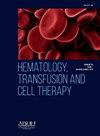Updating the Brazilian clinical practice guidelines for sickle cell disease: Recommendations and development process
IF 1.6
Q3 HEMATOLOGY
引用次数: 0
Abstract
Background
Sickle cell disease is a hereditary blood disorder that significantly impacts morbidity and mortality, requiring comprehensive care. In Brazil, its management in the National Health Service follows the Brazilian Clinical Practice Guidelines, based on evidence and expert consensus. Periodic updates ensure alignment with new scientific findings.
Objectives
This study describes the methodology for updating the clinical guidelines for sickle cell disease and provides an overview of recommendations for diagnosis, treatment and monitoring, emphasizing the evidence and health technology assessments for prioritized technologies.
Methods
The update followed the technical guide of the Brazilian Ministry of Health, and the Gradings of Recommendation, Assessment, Development and Evaluation (GRADE) approach. All the recommendations were assessed by the National Committee for Health Technology Incorporation (Conitec). The clinical guidelines panel included health technology assessment researchers, clinical experts, and policymakers. Systematic reviews assessed new evidence with stakeholder contributions being incorporated through public consultation. Cost-effectiveness analysis was applied to support new technology coverage or changes.
Results
The updated clinical guidelines provide structured recommendations for screening, diagnosis, prophylaxis, vaccination, and treatment, covering pharmacological and non-pharmacological approaches. It emphasizes patient and caregiver education to promote early recognition of complications. Expected benefits include fewer pain crises, fewer hospitalizations and transfusions, and improved fetal hemoglobin level, quality of life and survival rates. Key updates include listing epoetin alfa and 100 mg hydroxyurea tablets, expanding hydroxyurea eligibility criteria and revising monitoring protocols.
Conclusion
The updated clinical practice guidelines standardize sickle cell disease care in the Brazilian NHS aligned with current evidence. Dissemination and integration aim to enhance healthcare delivery, while future assessments should optimize real-world implementation.
更新巴西镰状细胞病临床实践指南:建议和发展过程
镰状细胞病是一种严重影响发病率和死亡率的遗传性血液疾病,需要全面的护理。在巴西,其在国家卫生服务体系中的管理遵循基于证据和专家共识的《巴西临床实践指南》。定期更新确保与新的科学发现保持一致。本研究描述了镰状细胞病临床指南的更新方法,概述了镰状细胞病的诊断、治疗和监测建议,强调了优先技术的证据和卫生技术评估。方法更新遵循巴西卫生部的技术指南,采用推荐、评估、开发和评价分级(GRADE)方法。所有建议都由国家卫生技术公司委员会(Conitec)进行了评估。临床指南小组包括卫生技术评估研究人员、临床专家和政策制定者。系统审查评估了新的证据,并通过公众咨询纳入了利益攸关方的贡献。应用成本效益分析来支持新技术的覆盖或变更。结果更新后的临床指南为筛查、诊断、预防、接种和治疗提供了结构化的建议,涵盖了药物和非药物方法。它强调对患者和护理人员的教育,以促进对并发症的早期识别。预期的好处包括更少的疼痛危机,更少的住院和输血,改善胎儿血红蛋白水平,生活质量和存活率。主要更新包括列入epoetin alfa和100mg羟基脲片,扩大羟基脲资格标准和修订监测方案。结论:最新的临床实践指南与目前的证据一致,使巴西国家医疗服务体系的镰状细胞病护理标准化。传播和整合旨在加强医疗保健服务,而未来的评估应优化现实世界的实施。
本文章由计算机程序翻译,如有差异,请以英文原文为准。
求助全文
约1分钟内获得全文
求助全文
来源期刊

Hematology, Transfusion and Cell Therapy
Multiple-
CiteScore
2.40
自引率
4.80%
发文量
1419
审稿时长
30 weeks
 求助内容:
求助内容: 应助结果提醒方式:
应助结果提醒方式:


